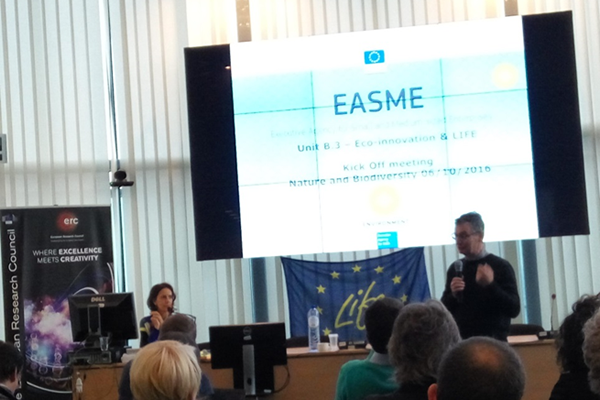LIFE BACCATA project presents its yew forest conservation initiative in Brussels
25-11-2016

The coordinating beneficiary (IBADER) of the LIFE BACCATA project (LIFE15 NAT/ES/000790) participated last October 6th in the kick off meeting held by the European Commission within the framework of the LIFE programme. The meeting, which took place at the premises of the Executive Agency for Small and Medium-sized Enterprises (EASME) in Brussels (Belgium), served to present the different LIFE projects of the 2015 call that were approved to those responsible for the European Commission. However, it also provided a great opportunity for the European Commission and the beneficiary entities to exchange their points of view during the different round tables. This allowed for closer ties and strengthened potential synergies for future collaborations.
The LIFE BACCATA project aims to improve the conservation status of the priority habitat type 9580* "Mediterranean forests of Taxus baccata" in 15 protected areas of the Natura 2000 Network in the Cantabrian Mountains, increasing its area of occupation, improving its structure and functionality, as well as its future prospects. The project also includes a series of measures for the dissemination and transmission of the results obtained, as well as an information and awareness-raising programme for the general public on the importance of the 9580* habitat, the biodiversity values harboured, and the services provided by the ecosystems treated by the project. The coordinating beneficiary of the project is IBADER of the Lugo Campus of the USC, and it has 3 associated beneficiaries: CESEFOR Foundation, Junta de Castilla y León and HAZI Fundazioa. The total budget is 1,925,104 €, 75% financed by the European Union (1,441,649 €), which is the maximum amount granted by the LIFE call for projects that are considered a priority for their execution and launch.
Habitat type 9580* consists of forests dominated by Taxus baccata, often with Ilex aquifolium, the presence of which is very localised. This habitat can have two origins: as a senescence phase of beech or spruce forests formed after the disappearance of the larger species, from yew stands and forming mosaics with multi-stratified beech-yew forests; as final stages of forests in which yew survives larger species located above or in their vicinity.
In the presentation to the Commission, special emphasis was placed on the territorial magnitude of the LIFE BACCATA project, which covers a significant area of the area of presence of habitat type 9580* in Spain. On the other hand, in addition to the restoration and direct improvement of the habitat type, the genetic characterisation of the yew (Taxus baccata) populations in the Cantabrian Mountains was also highlighted, which will make it possible to know its genetic variability and contribute to its conservation.
The LIFE BACCATA project aims to improve the conservation status of the priority habitat type 9580* "Mediterranean forests of Taxus baccata" in 15 protected areas of the Natura 2000 Network in the Cantabrian Mountains, increasing its area of occupation, improving its structure and functionality, as well as its future prospects. The project also includes a series of measures for the dissemination and transmission of the results obtained, as well as an information and awareness-raising programme for the general public on the importance of the 9580* habitat, the biodiversity values harboured, and the services provided by the ecosystems treated by the project. The coordinating beneficiary of the project is IBADER of the Lugo Campus of the USC, and it has 3 associated beneficiaries: CESEFOR Foundation, Junta de Castilla y León and HAZI Fundazioa. The total budget is 1,925,104 €, 75% financed by the European Union (1,441,649 €), which is the maximum amount granted by the LIFE call for projects that are considered a priority for their execution and launch.
Habitat type 9580* consists of forests dominated by Taxus baccata, often with Ilex aquifolium, the presence of which is very localised. This habitat can have two origins: as a senescence phase of beech or spruce forests formed after the disappearance of the larger species, from yew stands and forming mosaics with multi-stratified beech-yew forests; as final stages of forests in which yew survives larger species located above or in their vicinity.
In the presentation to the Commission, special emphasis was placed on the territorial magnitude of the LIFE BACCATA project, which covers a significant area of the area of presence of habitat type 9580* in Spain. On the other hand, in addition to the restoration and direct improvement of the habitat type, the genetic characterisation of the yew (Taxus baccata) populations in the Cantabrian Mountains was also highlighted, which will make it possible to know its genetic variability and contribute to its conservation.

The presentation was welcomed by the members of the Commission, who rated it positively, highlighting the high skills and experience of the staff involved in the project. The European Commission also emphasised the replicability and transferability of LIFE BACCATA to other European projects dealing with forest conservation in general, and badlands in particular. In this sense, the initiation of contacts established before the start of the project, such as the visit to the LIFE TAXUS project in Portugal, during the workshop held last June 2016 in Serra da Estrela, in Manteigas, was very positively valued.

LIFE BACCATA is an example of the experience and commitment acquired by the project beneficiaries in the conservation and restoration of natural ecosystems by maintaining or restoring habitat types and species of Community interest to a favourable conservation status.





